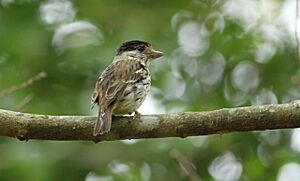African broadbill facts for kids
Quick facts for kids African broadbill |
|
|---|---|
 |
|
| Conservation status | |
| Scientific classification | |
| Synonyms | |
|
Platyrhynchus capensis A. Smith, 1839 |
The African broadbill (Smithornis capensis) is a small bird found in Africa. People also call it the black-capped broadbill or Delacour's broadbill. It belongs to a bird family called Calyptomenidae.
Contents
What Does It Look Like?
The African broadbill is a strong, brownish bird with bold streaks. It looks a bit like a flycatcher. Males have a black cap on their head, while females in eastern areas have a grey cap. Other types (subspecies) have blackish caps for both sexes.
Its upper body is mostly olive-brown with black streaks. The feathers on its lower back and rump are white at the bottom. You can't see these white parts when the bird is resting. Its belly is buff or creamy-white with black streaks on its sides and chest. Some types of African broadbills are whiter underneath with thicker streaks.
This bird is about 12 to 14 centimeters (5 to 5.5 inches) long. In South Africa, males weigh about 21 to 27 grams (0.7 to 0.9 ounces). Females weigh about 17 to 28 grams (0.6 to 1 ounce).
How Does It Make Sound?
The African broadbill makes a very loud sound. It sounds like an old car horn! This loud, vibrating "Prrrrup" sound happens when the bird flies in a special way. Before this loud sound, it might make softer "tui-tui-tui" calls. Sometimes, it makes these softer calls without the "car horn" sound.
What's really cool is how it makes this sound. Unlike most birds that sing with their voices, the African broadbill makes its call with its wings! As it flies, its sixth and seventh primary feathers (long flight feathers) vibrate. This vibration creates the unique "car horn" sound.
Where Does It Live?
The African broadbill lives in Africa. It is found mainly in the southeastern part of the continent. There are two main areas where it lives, which are quite far apart.
One area is along the coast of West Africa. This stretches from Sierra Leone in the west to the Central African Republic in the east. It also goes south to Gabon and the northern Congo.
The other, larger area covers southern and eastern Africa. This goes from Kenya in the north down to KwaZulu Natal in South Africa.
What Kind of Home Does It Like?
The African broadbill prefers to live in dense forests and woodlands. It likes evergreen forests or lowland forests. You can also find it in thick, leafy areas or dense woodlands. It often lives near rivers in what are called "gallery forests." These are forests that grow like a tunnel along a river.
What Are Its Habits?
It can be hard to spot the African broadbill. This is because it likes dense forests and usually stays hidden. It often sits very still for a long time. It perches upright on a low branch and doesn't call very often.
This bird eats only small creatures without backbones, called invertebrates. It looks for food on the ground and in trees. Sometimes, it even catches insects while flying. It eats beetles, grasshoppers, Hemiptera (true bugs), caterpillars, and spiders.
Both male and female birds do a special display flight. They fly in circles around a branch, about one meter away. Their wings flutter very fast. They puff out their back and rump feathers to show the white parts. While doing this, they make their loud "car horn" call.
The nest is shaped like an oval with an opening on the side. Both the male and female build it. They use bark, dry leaves, small twigs, grass, and roots. They often use spider webs to hold it all together. The nest hangs from a low tree branch, usually about 1.5 to 3 meters (5 to 10 feet) above the ground.
The time when they lay eggs changes depending on the country. But it is usually between October and January. They lay 1 to 3 eggs. The female bird sits on the eggs by herself for 16 to 17 days. The male bird guards the nest. He makes a high-pitched call if there is danger. We don't know much about how the young birds grow. But the male bird is the main one who brings food to the babies.
How Was It Named?
The name of the group of birds, Smithornis, honors a Scottish scientist and explorer. His name was Dr Andrew Smith. He was the first person to describe this bird in 1839. He originally called it Platyrhynchus capensis.
There are different types of African broadbills, called subspecies. These different types live in various parts of Africa.
Is It Endangered?
The African broadbill lives in a very large area and is common in many places. In southern Africa, it is found in scattered spots. This is because its home (habitat) has been broken up into smaller pieces.
Overall, experts consider it a "least-concern species". This means it is not in danger of disappearing. However, in some local areas, it can be at risk. This happens when its forest home is lost.
This bird lives in forests, dense woodlands, and thickets along rivers.


